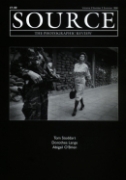Everyday Occurrences
Peter Houston was at the Clotworthy Arts Centre, 3rd June - 28th June 1996
Review by Michael Crone
Issue 8 Summer 1996
View Contents ▸
Initial preconceptions, derived from the title suggested an insight into the singles culture, the lads' night out, casual army, lager and cumbersome seduction attempts with inebriated females wearing white high heels. This, however, could not be further from the truth. Peter Houston comments on the relationship between people and place, drawing direct comparison between Western and Indian cultures. The directive statement 'There is no real difference in their place or ours', reveals Houston's agenda immediately, making connections rather than distinctions between the world's societies.
Houston focuses on the intimate/human elements of life, to project his views, avoiding the particularities of civilisation. The enforced theme of people, place and consequent interaction is revealed in everyday occurrences/ routines, which have evolved through necessity rather than stipulation. The common denominators; Eating, Sleeping, Defecating, Washing, Dressing, Building, Reproducing, Dying, Growing, Homeostasis, are reflected by the simple approach to presentation. Double-image mounts initiate a deliberate dialogue, revolving around a varied range of images. The twenty nine pieces are formed from formal portraits and landscapes which combine in scenes or events such as markets, schools and shops. The formats provide an interesting range of approach, static compositions contrasting to 'snapshot' images of social activities.
The photograph 'Ahmedabad Fruit Market' presents an insight to the simple elements of Indian lifestyle, which is so often ignored by Western media, intent on representing the extremes of poverty and disease. The scene is rich in colour, atmosphere and interpersonal communication. The composition is split by market stalls on which a myriad of detail forms a plane of colour and texture, effectively dividing the piece in two. Figures position themselves on either side, with heads providing focus, as they recede to the background. The wide range of reds and browns provide depth and space while retaining a thick atmosphere.
Peter Houston, takes the notion, regarding the similarities in human existence. Everyday routines, religions, politics, and interpersonal relationships, are all based around the same aspirations and needs. Humans as individuals and in collective groups, interact with each other and with the surrounding environment, with primarily the same manner, evolving the same patterns and processes. He reacts to the cliches associated with the Western perception of other cultures, misguided by lack of insight and generic insecurity. The 'others', are seen as inferior, affirmed by images of plight and helplessness, maintaining a self importance. This ignores the details and similarities between two societies, tangible on a 'personable' level. In this respect Houston is justified, and so projects the issue directly.
Peter Houston is correct; there is no real difference in their place or ours, but only to a level. The described events are mundane and in effect subconscious processes. I feel it is the non-tangible particular details and stipulations of the compared cultures which tend to rule ones life. It is also the differences in people, places and culture that makes the world interesting enough to describe through visual media. The medium of photography, by its nature, invokes individual perception/interpretation, which in this case is blinkered by the intentions.
Other articles by Michael Crone:
Other articles on photography from the 'Documentary' category ▸






